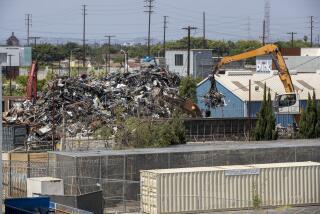Op-Ed: Flint’s toxic water crisis was 50 years in the making

Members of the Michigan National Guard load bottled water at a fire station on Jan. 28 in Flint, Mich.
In the fall of 1966, African American activists from the impoverished North End of Flint, Michigan, turned out en masse for a series of hearings on racial inequality sponsored by the state’s Civil Rights Commission. One of those who testified, Ailene Butler, drew links between the segregationist policies that had created the North End and the corporate practices that had immiserated its inhabitants.
Butler owned a funeral parlor not far from a massive complex of smoke-belching Buick factories operated by General Motors. A throat cancer survivor, she spoke at length about the dreadful conditions that existed in her neighborhood: “There is a heavy smog caused by the Buick factory, which has been in existence for about 18 years.... The houses in this district are eaten up by a very heavy deposit, something like rust.... You can imagine what we go through down there breathing when this exists on just material things.”
When asked why she and her neighbors had not simply moved away, Butler pointed out that discriminatory real estate practices — particularly redlining — had trapped black people in the North End. “No matter what their credit is, no matter how many years they’ve been working for Buick.... They have no place [else] to go.”
Although the plants that once choked Butler’s lungs are long gone, structural inequality and environmental degradation are still twin problems today in Flint, a city now constantly in the news thanks to a toxic water crisis.
———————
Many details surrounding Flint’s latest disaster have recently come to light. Here is what we know so far: In November 2011, Michigan Gov. Rick Snyder, after declaring that the city was in a state of financial emergency, appointed the first in a series of four unelected managers who have controlled municipal government for much of the past several years. Their mandate was to cut costs and balance budgets. Between that time and April 2015, when Snyder declared Flint’s emergency resolved and turned the municipality over to an advisory board, the governor’s appointees implemented a series of reforms they claimed would return Flint to financial solvency. Chief among these was the decision to cancel Flint’s longstanding water agreement with Detroit in order to join a newly formed regional water authority that had proposed to build a pipeline to Lake Huron. Boosters proclaimed that the pipeline would save the city $18 million over eight years, but it could not be completed until well into 2016. To meet immediate water needs, Flint’s emergency managers elected to use the polluted Flint River.
Since that switch occurred in the spring of 2014, local citizens have complained of discolored, foul-tasting, awful-smelling water. This water, which has made many sick, is laced with toxic levels of lead. According to medical experts, the lead exposures that have occurred are likely to have lifelong detrimental health effects on an as yet undetermined number of residents.
As with so many environmental disasters, this one was preventable. Evidence suggests that the simple failure to use proper anti-corrosive agents led to the leaching of lead into the city’s water. It has also become apparent that the slow responses of local, state and federal officials to this crisis — as well as their penchant for obfuscation — prolonged the lead exposure.
It would be a mistake, however, to conclude that Flint’s predicament is simply the result of government mismanagement. It’s also the product of a variety of larger structural problems that are much more difficult to untangle and remedy.
Over the past three-quarters of a century, waves of deindustrialization, disinvestment and depopulation eviscerated Flint’s tax base, making it all but impossible to improve — or even maintain — the city’s crumbling infrastructure. Flint — which once claimed 200,000 residents — now contains fewer than 100,000, nearly half impoverished, more than half African American. The economic prospects of locals are grim. After decades of plant closures and layoffs, GM’s workforce in the area, which once surpassed 80,000, is less than 10,000. The hemorrhaging of jobs has produced unemployment rates that routinely reach into the double digits.
Among the many forces behind Flint’s economic plunge were two migrations, both government sanctioned. Following World War II, GM, like other American companies, took advantage of local, state and federal subsidies that encouraged the relocation of industry from cities to suburbs and rural areas. Over the same period, the home mortgage insurance programs implemented by the Federal Housing Administration and the Veterans Administration enabled millions of white Americans — including tens of thousands of Flint residents — to relocate from central cities to racially homogeneous suburbs.
Because lenders and government officials largely excluded African Americans from participating in such programs and categorically refused to issue mortgages in many urban neighborhoods, federal housing policies contributed to increasing levels of racial segregation. These policies also deepened the economic chasms between majority-black cities such as Flint and the predominantly white suburbs surrounding them.
Signs of economic distress appeared in Flint as early as the 1950s and 1960s, when city officials began confronting periodic budget shortfalls. Over the past generation, though, as Flint’s urban crisis gathered momentum, the quality of city services and the state of Flint’s infrastructure declined dramatically.
On the ground, Flint’s economic troubles translated into deep service cuts, layoffs for municipal workers, a host of new fees for basic services, deferred maintenance on the city’s increasingly decrepit infrastructure, and, of course, the state takeover that led to the current calamity. What is happening now is in many ways a culmination of Flint’s long-established urban crisis.
If there was ever a canary in Flint’s coal mine, it may have been Ailene Butler. When she stepped forward in 1966, she crystallized the tight connections between environmental inequality and social injustice. To be sure, much has changed since Butler sounded the alarm half a century ago. Whereas in the 1960s it was the encroachment of industrial plants upon black neighborhoods that fueled local resentment, Flint’s current water crisis stems in many ways from the absence of those plants — and the jobs, taxes, services and infrastructure they supported. Still, looking ahead at Flint’s uncertain future, Butler’s message seems more relevant than ever.
Andrew R. Highsmith is an assistant professor of history at UC Irvine, and author of “Demolition Means Progress: Flint, Michigan, and the Fate of the American Metropolis.”
Follow the Opinion section on Twitter @latimesopinion and Facebook
More to Read
A cure for the common opinion
Get thought-provoking perspectives with our weekly newsletter.
You may occasionally receive promotional content from the Los Angeles Times.






